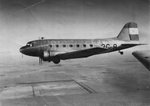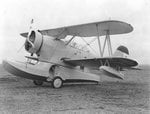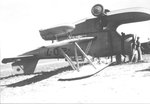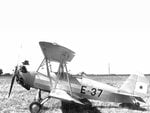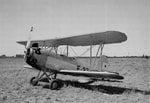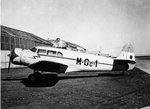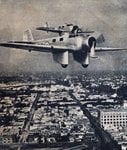Interesting shots!
Navigation
Install the app
How to install the app on iOS
Follow along with the video below to see how to install our site as a web app on your home screen.
Note: This feature may not be available in some browsers.
More options
You are using an out of date browser. It may not display this or other websites correctly.
You should upgrade or use an alternative browser.
You should upgrade or use an alternative browser.
South American Air Forces
- Thread starter gekho
- Start date
Ad: This forum contains affiliate links to products on Amazon and eBay. More information in Terms and rules
More options
Who Replied?- Thread starter
- #62
- Thread starter
- #63
The Douglas DC-2 was a 14-seat, twin-propeller airliner produced by the American company Douglas Aircraft Corporation starting in 1934. It competed with the Boeing 247. In 1935 Douglas produced a larger version called the DC-3, which became one of the most successful aeroplanes in history. Five used units were bought in Venezuela. When the planes arrived to Argentina, they were in very bad conditions and it was decided to replace their engines, being fitted the Glen Martin B-139 WAN. They were destinated to the Naval transport Squadron, operating between 1946 and 1958. Four of them were sold in 1959.
Attachments
Last edited:
- Thread starter
- #64
The Grumman J2F Duck (company designation G-15) was an American single-engine amphibious biplane. The J2F was an improved version of the earlier JF Duck, differing by having a longer float. The J2F-1 Duck first flew on 2 April 1936 powered by a 750 hp (559 kW) Wright R-1820 Cyclone, and was delivered to the US Navy on the same day. The J2F-2 had a Wright Cyclone engine but boosted to 790 hp (589 kW). 20 J2F-3 variants were built in 1939 for use as executive transports for the Navy with plush interiors. Due to pressure of work following the United States entry into the war in 1941, production of the J2F Duck was transferred to the Columbia Aircraft Corp of New York. They produced 330 aircraft for the Navy and US Coast Guard. Several surplus Navy Ducks were converted for use by the United States Air Force in the air-sea rescue role as the OA-12 in 1948.
Attachments
- Thread starter
- #65
15 units were acquired between 1939 and 1940. The differences between the G-15 and G-20 were only on the propeller. They served on Observation Squadron of the Fleet and some of them were embarked in the argentinian navy cruisers between 1939 and 1947, when they were replaced by the J2F5 and 6.
Attachments
Good stuff!
- Thread starter
- #68
15 units were acquired in cotober 1935, and armed at the BAPI workshop. Later 13 unit more were construted under license. Destinated to the ESAN squadron, they were nicknamed "Kelitos", due to its small size and yellow colour. When they were retired from service in 1957, many of them were donated to private Aeroclubsan to the Aeronautical Departament of the Argentinian goverment
Attachments
- Thread starter
- #69
The Argentinian Navy acquired three units on 1937. By that time this magnificent product of the Curtiss was having a successful life, and the Navy used one of them as a transport and parachute aircraft, another one as VIP transport and the last one as flying ambulance. They were the pioneers of the Aeronaval Transport Command, and after many years of services, they were retired in 1947. These three Condors were the last ones built at the Curtiss´s St. Louis factory, and they were bought to transport the Wrights engines, due to their big deck.
Attachments
Nice shots!
TheMustangRider
Senior Airman
Great information coupled with great photographs.
I wonder if you have some photographs of the "Soccer War" between El Salvador and Honduras in 1969 in which, as far as I know was the last conflict where WWII era prop-driven fighters were utilized as weapons to achieve air supremacy and in which the last Corsair was shot down ironically by another Corsair.
Thanks for sharing this information with us.
I wonder if you have some photographs of the "Soccer War" between El Salvador and Honduras in 1969 in which, as far as I know was the last conflict where WWII era prop-driven fighters were utilized as weapons to achieve air supremacy and in which the last Corsair was shot down ironically by another Corsair.
Thanks for sharing this information with us.
CharlesBronson
Senior Master Sergeant
Nice work gekho, but most of the aircraft you ve posted under the tag "argentina air force" are in fact from the Armada, Navy.
The only proper air force (army air force to be more precise since the air force as independent arm was created in only 1947) is the P-36 Hawk.
It is mirrored indeed, the caption is reversed in the 2nd photo.
The only proper air force (army air force to be more precise since the air force as independent arm was created in only 1947) is the P-36 Hawk.
thinking aloud; ducks 4 and 6 - while probably different negs - possibly the same plane, just mirrored?
It is mirrored indeed, the caption is reversed in the 2nd photo.
Last edited:
- Thread starter
- #73
I wonder if you have some photographs of the "Soccer War" between El Salvador and Honduras in 1969
Actually I am posting all the pictures I have of the South american Air Forces. As I said at the beggining of this thread, I dont have many photos and I would had prefered to face this matter in a better way. Perhaps in a future I will get more and better pictures, but right now this is all I have.
- Thread starter
- #74
Nice work gekho, but most of the aircraft you ve posted under the tag "argentina air force" are in fact from the Armada, Navy.
Yes, I know, but this thread is about the Air Forces, and I prefered to put them all under the same title. In any case if you have seen the text translation I usually remark it. By the way, I have tried to find information about the Argentinian Air Force, but it is being quite difficult. It seems the Air Force was created later than the Navy Air Arm. First time I see this....
- Thread starter
- #75
During 1934, the Fairchild company designed a business or executive aircraft with five seats, designated the Model 45. It first flew on 31 May 1935. The Model 45 was a low-wing cantilever monoplane with a conventional cantilever tail unit and a retractable tailwheel landing gear. The aircraft was powered by a 225 hp (168 kW) Jacobs L-4 radial engine and had a luxury five-seat interior as standard. Flight testing showed that the aircraft performed well although it was described as sedate. Fairchild upgraded the protoype with a larger engine, the Wright R-760 radial, for evaluation. In this configuration it was designated the Model 45-A. This configuration was placed in production, with about 16 units being completed. Argentina bought three units in 1937 for the Navy, to be used as VIP transport and photografic aircraft. They were retired in 1948.
In 1929-1930, Fairchild (Canada) designed an eight-seat transport known as the Model 81. The single prototype was powered by either a 575 hp Pratt Whitney Hornet or Armstrong Siddeley Jaguar. The design was a "one-off" and did not enter production. In 1934, the parent company had also developed the Super 71 variant of the Fairchild 71, but reception in the marketplace was lukewarm. Undaunted, the company continued to refine the design and produced the Model 82 the following year. This retained the stretched forward fuselage and separate flight deck that had been a feature of the Super 71, but increased passenger and load capacity. The resulting aircraft proved a modest success, with three sold to the government of Venezuela, one to the government of Mexico, and another seven going to various Canadian regional airlines. Variants with various powerplant changes followed, three of which were sold to the Argentine Navy. They were retired in 1947.
In 1929-1930, Fairchild (Canada) designed an eight-seat transport known as the Model 81. The single prototype was powered by either a 575 hp Pratt Whitney Hornet or Armstrong Siddeley Jaguar. The design was a "one-off" and did not enter production. In 1934, the parent company had also developed the Super 71 variant of the Fairchild 71, but reception in the marketplace was lukewarm. Undaunted, the company continued to refine the design and produced the Model 82 the following year. This retained the stretched forward fuselage and separate flight deck that had been a feature of the Super 71, but increased passenger and load capacity. The resulting aircraft proved a modest success, with three sold to the government of Venezuela, one to the government of Mexico, and another seven going to various Canadian regional airlines. Variants with various powerplant changes followed, three of which were sold to the Argentine Navy. They were retired in 1947.
Attachments
- Thread starter
- #76
The Douglas Dolphin was an amphibious flying boat. While fewer than 60 were built, they served a wide variety of roles: private " air yacht", airliner, military transport, and search and rescue. It began in 1930 as the twin-engine "Sinbad," intended as a luxury aircraft. It was a high-wing monoplane, with two radial engines mounted above the wing. Its six to eight passengers looked out picture windows, and their baggage was stored in a 30-cubic-foot area. The Depression curtailed demand for such extravagance, so the Sinbad was sold to the United States Coast Guard. 58 of the next version, the Dolphin, were built between 1931 and 1934. The Dolphin retracted its landing gear for water landings and evolved into 17 variants to meet military or civilian needs. It . Among the first purchasers were the Wilmington – Catalina Airline and Standard Oil of New Jersey.
A sigle unit was sold to Argentina in 1933. It served with the Navy Departament and also as a transport aircraft and giving logistic support to the operative squadrons. It was retired in 1948.
A sigle unit was sold to Argentina in 1933. It served with the Navy Departament and also as a transport aircraft and giving logistic support to the operative squadrons. It was retired in 1948.
Attachments
- Thread starter
- #77
The Fleet Model 1 (originally the Consolidated Model 14 Husky Junior) and its derivatives were a family of two-seat trainer and sports plane produced in the United States and Canada in the 1920s and 30s. They all shared the same basic design and varied mainly in their powerplants. They were all orthodox biplanes with staggered, single-bay wings of equal span and fixed tailskid undercarriage. The model 11 was a version with Kinner R-5 engine. Ten units were sold to Argentina in 1931 and used as advanced trainers. They were retired in 1940.
Attachments
- Thread starter
- #78
Originally designed as a two-seat civilian biplane for pilot training and sport flying, the Stieglitz (German for Goldfinch) prototype first flew in 1932. After test and modifications to increase the plane's strength and improve its flight characteristics, the final Fw 44 design proved to have excellent maneuverability and aerobatics capabilities. Famous German pilots of the 1930s including Ernst Udet, Gerd Achgelis and Emil Kopf all flew the Stieglitz in aerobatic displays and air shows in Germany, and flight schools and flying clubs placed orders for the new plane in large numbers. The demand was so great that Focke-Wulf opened a new factory just to build the Stieglitz. Orders also came from a dozen other countries and in some, Fw 44s were produced under license.
A second version of the design was the Fw 44B, which used an Argus As 8 four-cylinder inverted inline air-cooled engine of 120 horsepower. This gave the plane a more slender, aerodynamic nose that the bulkier Siemens radial engine. This model was produced in limited numbers and followed by the Fw 44C. The final C model was powered by the Siemens radial engine and was produced in the largest numbers. With a fuselage of welded steel-tube and wings of wooden spars and ribs, the Stieglitz design was fabric covered with metal panels behind the engine. The two cockpits were open, with the pilot or student pilot flying from the rear cockpit and a passenger or instructor in front.
In 1940 four units were acquired and delivered to Argentina, being used mainly for trainning and acrobatic duties. They were later used as a general purpose aircrafts until 1958. By that time they were stored and in 1967 the last survivor was donated to the Veronica Aeroclub.
A second version of the design was the Fw 44B, which used an Argus As 8 four-cylinder inverted inline air-cooled engine of 120 horsepower. This gave the plane a more slender, aerodynamic nose that the bulkier Siemens radial engine. This model was produced in limited numbers and followed by the Fw 44C. The final C model was powered by the Siemens radial engine and was produced in the largest numbers. With a fuselage of welded steel-tube and wings of wooden spars and ribs, the Stieglitz design was fabric covered with metal panels behind the engine. The two cockpits were open, with the pilot or student pilot flying from the rear cockpit and a passenger or instructor in front.
In 1940 four units were acquired and delivered to Argentina, being used mainly for trainning and acrobatic duties. They were later used as a general purpose aircrafts until 1958. By that time they were stored and in 1967 the last survivor was donated to the Veronica Aeroclub.
Attachments
- Thread starter
- #79
The "Fabrica Militar de Aviones" (FMA) AeMB.2 Bombi was a bomber aircraft developed in Argentina in the mid 1930s. It was a low-wing cantilever monoplane of conventional configuration. It was fitted with fixed tailwheel undercarriage, the main units of which were covered by long, "trouser"-style fairings. The initial AeMB.1 configuration was fitted with a dorsal machine gun turret, later removed from the AeMB.2 to improve stability. Fifteen production examples saw service with the Argentine Air Force between 1936 and 1945. Only two were lost to air accidents.
Attachments
TheMustangRider
Senior Airman
Understood mate, thanks again for taking your time posting all this information and pictures about these less known Air Forces which certainly deserve their place in history.Actually I am posting all the pictures I have of the South american Air Forces. As I said at the beggining of this thread, I dont have many photos and I would had prefered to face this matter in a better way. Perhaps in a future I will get more and better pictures, but right now this is all I have.
Users who are viewing this thread
Total: 1 (members: 0, guests: 1)





